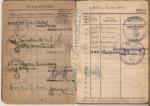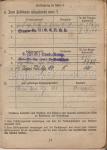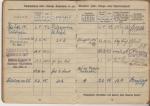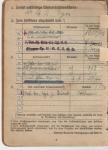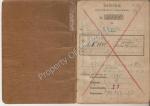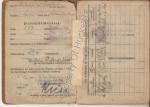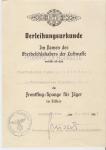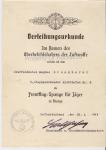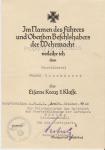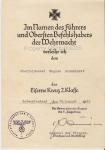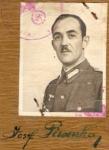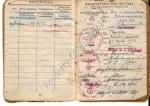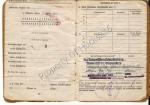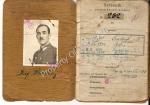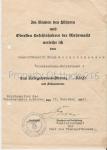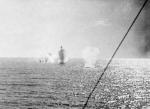-
Posts
3,680 -
Joined
-
Last visited
-
Days Won
9
Content Type
Profiles
Forums
Blogs
Gallery
Events
Store
Everything posted by hucks216
-
In November 1944 it was decided to establish a Panzerkorps Grossdeutschland and to assist with this formation GD surrendered both III Battalions from the Pz.Grenadier & Füsilier Regiments to the new formation as it was established between December 1944 and January 1945. Both III Btl's were used to form Panzerkorps Füsilier Regiment Grossdeutschland with III/Pz.Gren.Rgt GD becoming the I Btl and Kiesswetter being assigned to the 5 (Gr.Wf.) Kp. However when the Russians continued to thrust into East Prussia in early 1945 the only division sized unit able to be sent against them was GD and so it set off once more and even though it had recently been detached to form Pz.Kps.Füs.Rgt GD, the old III./Pz.Gren.Rgt GD went with it. However nothing could stop the Russian advances and GD were forced to withdraw time and again until they were in an area to the southwest of Königsberg. Advancing through the recently established Russian lines surrounding the city a slender corridor was established into the city but it was during the heavy and desperate fighting in early February that Kiesswetter’s war was to finally end when he received further shrapnel injuries on the 5th February 1945 and despite reaching Feldlazarett(m) 25 he died at 1310.
-
On the 24th July 1944 GD was detached from 8 Armee and moved north to East Prussia where they went on the offensive into Lithuania and Latvia. But the Russian advance continued and GD found itself in defensive battles once again, this time attempting to stop the Russians breaking through to the Baltic coast. However on October 5th 1944 the Russian 1st Baltic Front launched an offensive against the German 3 Pz.Armee and within a few days the front had collapsed and the Russian forces were positioned to the north and south of Memel trapping a number of forces within the Memel Bridgehead. One of these forces was Grossdeutschland and it was during the defensive fighting in the bridgehead that Kiesswetter won the EK I on the 9th October followed by his 6th (and final) Close Combat Day at Klauspussen with him also receiving another wound that day, a splinter in his hand, but this time he remained with the men in the front line. As the German forces still held the port they were able to evacuate some forces and near the end of November GD were evacuated by boat to Königsberg where they moved to positions to rest and refit between Rastenburg and Sensburg.
-
In Kiesswetter’s soldbuch is a slip showing the days he was awarded Close Combat Days and it was during the next phase that he was awarded 5 days, a good indication of how tough the fighting was. At the end of May 1944 the Russians had shifted their forces from the Targul Frumos area to an area north of Jassy looking for a weak point to attack. Pz.Gren.Div GD was ordered to an assembly area in the vicinity of Podul Iloaie and Letcani from where they attacked northward on 2nd June to sieze high ground and a series of key ridges that dominated the Prut Valley. Though they suffered heavy casualties at the hands of the Russian forces who could call on air support the men of GD reached their initial objectives, and the attack continued through the 5th June with GD seizing more key terrain. With the Russian counterattacks ceasing on the 7th June GD consolidated their positions and by the middle of June had handed over the hard won terrain to the Romanians so the division could move south behind the Romanian forces into counter attack positions.
-
1944 started for Kiesswetter with a promotion to Unteroffizier before he was sent back to the front line, and was again assigned to III./Pz.Gren.Rgt GD sometime in February, although he went to the 12 Kompanie instead of his previous 13 Kp. At this time GD was in the area of Kirovograd in the Ukraine as a component of 8 Armee. Having defeated a Russian attempt to encircle 8 Armee in January 1944 the sector quietened down as the Russians went on the defensive which allowed GD to bring reinforcements forward and build up its numbers. It is reasonable to assume that it was during this period that Kiesswetter reached the front line again after a year’s absence. And it wasn’t long before he saw action as on the 8th March the Russians attacked Grossdeutschland head-on with the attack directed at the boundary between Füsilier Rgt GD & Pz.Gren.Rgt GD, achieving a 5km penetration of the German frontline. Attack and counterattack followed over the next week as the division tried to buy time as it retreated into Romania. What was to follow in March and April was the well known fighting at Targul Frumos and Jassy where the GD Division dealt serious blows to the Russian attempts to advance through Romania, inflicting heavy losses on the Red Army including one audacious counterattack that broke through the Russian front and swept into the Russian assembly areas.
-
The injury sustained by Kiesswetter was serious enough to see him spend the first 6 months of 1943 in the Lazarett system. While spending time in 3 different lazarett’s Kiesswetter received 3 combat awards for the fighting he had been involved with in 1942, namely the EK II (backdated to 11 days after he entered the first lazarett at Warsaw), Black Wound Badge and the Infantry Assault Badge In Bronze – all three were awarded while in Res.Laz IV Karlsbad-Meierhöfen. No doubt due to his injuries, Kiesswetter spent the remainder of 1943 in various training and replacement units of the Grossdeutschland organisation and so missed GD’s participation in the Battles Of Kharkov and Kursk and the heavy fighting around Krivoi Rog in the last months of the year.
-
During his first spell in the front lines with GD, Kiesswetter was involved in the German summer offensive in 1942 when the newly established Infanterie Division (mot.) GD was assigned as flank protection for XXXXVIII Pz.Korps and which saw the division advance south to the Donets River and attack the area around Rasdorskaja before being taken out of the line and placed in OKH Reserve. The remainder of the year saw GD involved in the 2 major battles centered around Rzhev, the first in September-October 1942 and the second in November 1942 to January 1943 fighting against the Soviet winter offensive (Operation Mars) against Heeresgruppe Mitte and which saw the division fight in piecemeal fashion and suffer massive casualties fighting in many sectors including in the Luchessa Valley, and which saw III/Gren.Rgt GD attached to 253 ID. It was during the fighting in the Luchessa Valley that Gren.Rgt GD lost its commander with Oberst Köhler being killed in action. Despite Russian penetrations of the salient the 9 Armee was able to defeat the Russian forces but it was at great cost in fighting men, particularly Grossdeutschland which was nearly destroyed. Kiesswetter received his first injury during this ferocious fighting. Although the entry on the Lazarett page shows that he entered Res.Laz. IX Warschau on the 9th December 1942 there is another entry that has the Feldpost Number for the ambulance unit 3./Kranken.Transport.Abt 503 dated for 1st December. He was admitted with shrapnel injuries. As an aside, in between these two Rzhev battles the two infantry regiments of GD underwent a change of name with GD 1 becoming Grenadier Rgt GD and GD 2 being renamed Füsilier Rgt GD and It was during this period that Kiesswetter received a promotion to Gefreiter
-
A recent acquisition for my collection, and a type that I have been after for some time, was a soldbuch to a member of the Grossdeutschland Division. I have 8 citation groups and 4 Wehrpasse to members of the division but not a single soldbuch and I didn't want one of the late war transfer types who were sent to the division from the Luftwaffe or Kriegsmarine etc so it took a bit of a long wait until I was able to acquire one that suited the billing down to the ground as Wilhelm Kieswetter joined Grossdeutschland in February 1942. Kiesswetter joined the military in 1942 at the age of 19 having been born in Buchau on 26th September 1922. His soldbuch was opened on 3rd February 1942 by 3(MG)Kp.Ers.Btl GD and it was with this training battalion that he underwent his basic training after which he was passed to 4./Feldersatz Btl GD before being assigned to 13./Infanterie Rgt GD 1 after Grossdeutschland had been reorganised from an Infanterie Rgt (mot.) to an Infanterie Division (mot.)
-
I agree that Brunkhorst would of hardly claimed a Whirlwind if he hadn't attacked one but what I find interesting from the report from 263 Sqdn is that while Brunkhorst (and whoever he was with) gained total surprise over Sgt Robinson (who was on his first operational sortie) the other Whirlwind was left completely alone, enough for it to complete two turns around the area and fly on.
-
Claims 18 Aug 40 - 9./JG 2 - Spitfire - Isle of Wight - 15.59 08 Jul 41 - 9./JG 2 - Spitfire - Calais-Marck - 15.48 06 Nov 41 - 9./JG 2 - Whirlwind - Pointe de Barfleur - 12.30 EK II - signed by General Ritter von Greim EK I - signed by General Kastner-Kirdorf Fighter Clasp in Bronze - signed (stamp) by Hptm Balthasar Fighter Clasp in Silver - signed by Hptm Greisert
-
Brunkhorst would go on to make 2 further claims, both in 1941 with one being a Spitfire and the other a Whirlwind flown by Sgt Robinson of 263 Sqdn. But as with his first claim there are doubts with his claim for the Whirlwind. Taken from the Operations Book of 263 Sqdn... 'They then flew on a North-Easterly course; as he did so White One saw two presumed ME.109s, orbitting about a mile inland, but thesedid not seem to have observed the Whirlwinds. White One called up White Two “Rats to Port” and at the same time confirmed that WhiteTwo was in no trouble and that he had forty gallons of petrol for each engine. White Two began weaving slightly behind and aboveWhite One.After White One had called “Rats”, White Two began weaving more vigorously. He appeared on both sides of White One but on crossingfrom port to starboard for the second time he failed to re-appear from behind White One. White One turned slightly to starboard andsame time calling up White Two. Absolutely no trace of White Two could be seen although White One completed two turns over the areain which White Two had last been seen – that is, about 10 miles North East of Barfleur. It is to be stressed that the two ME.109shad NOT followed the Whirlwinds and it seems certain that enemy action was not responsible for the disappearance of Sgt. Robinson.White One flew to base making landfall in Bournemouth Bay and landed at Warmwell at 1153.As no military targets had been seen neither of the Whirlwinds fired their guns.Air/Sea Rescue was maintained in the English South Coast area and in the person of P/O Tooth late of this Squadron, now with A/S/R Warmwell,as far as Cherbourg but no trace has been found of Sergeant Robinson.It seems likely that, while weaving he dipped his port wing into the sea and went into it at a very high speed.'
-
The most recent (i.e. today) addition to my collection. EK II & I and Fighter Clasp citations to Oberfeldwebel Magnus Brunkhorst who flew with 9./JG-2 Richtofen. His EK's were awarded during the Battle Of Britain receiving the EK II on 28th August 1940 and then the EK I on 28th October 1940 but by the latter date he had only one 'kill' - a Spitfire on 18th August. Looking through Battle Of Britain Then & Now the only 2 Spitfire casualties for that day that match the location (Isle Of Wight) & time (1559 German Time) of Brunkhorst's claim both made it back to base with damage but both pilots unharmed. It seems strange to win both awards with just a solitary kill, especially as I have an EK II citation awarded to a pilot of JG 51 during the BoB and he had shot down 3 aircraft by the time of his award so a little more digging may well be required to find out the 'why's and wherefores'.
-
'Needle and haystack' sprint to mind I'm afraid. There are organisations such as WASt that provide details on KIA/MIA German soldiers (although usually only to next of kin) but they would need the name and probably date of birth. Volksbund provide an online database for those KIA/MIA but again, you need at least a surname to obtain details of where & when he was born & killed. Maybe there is something in one of the archives in Germany & USA for his unit that can provide some sort of clue but that could be very time consuming and could have no end result for your efforts.
-

Heer WW2 Kriegs Chronik
hucks216 replied to AlecH's topic in Germany: Third Reich: Research, Documentation & Photographs
Very nice item. Strange how they go to all that effort and yet don't bother to put the units he served in.




